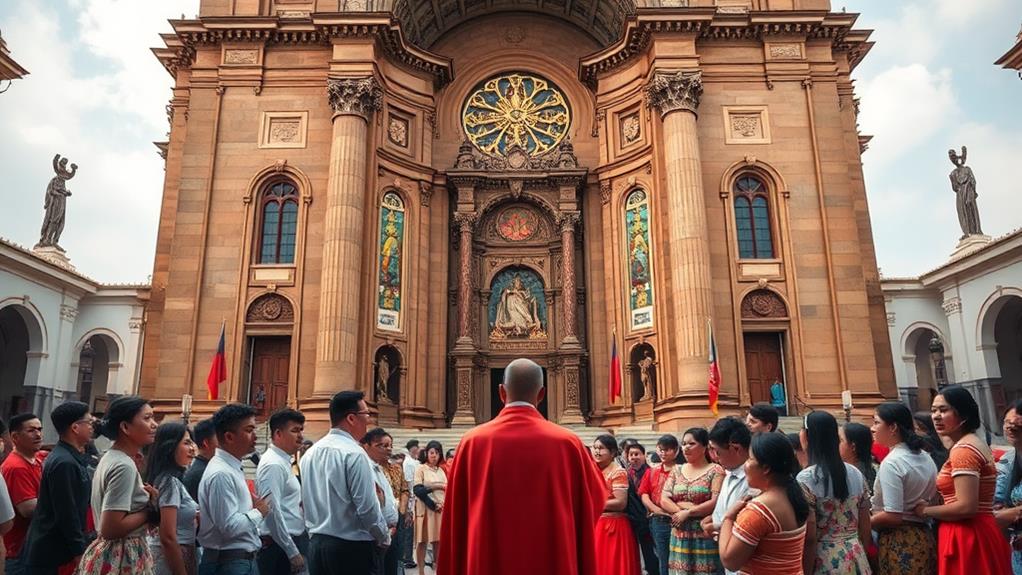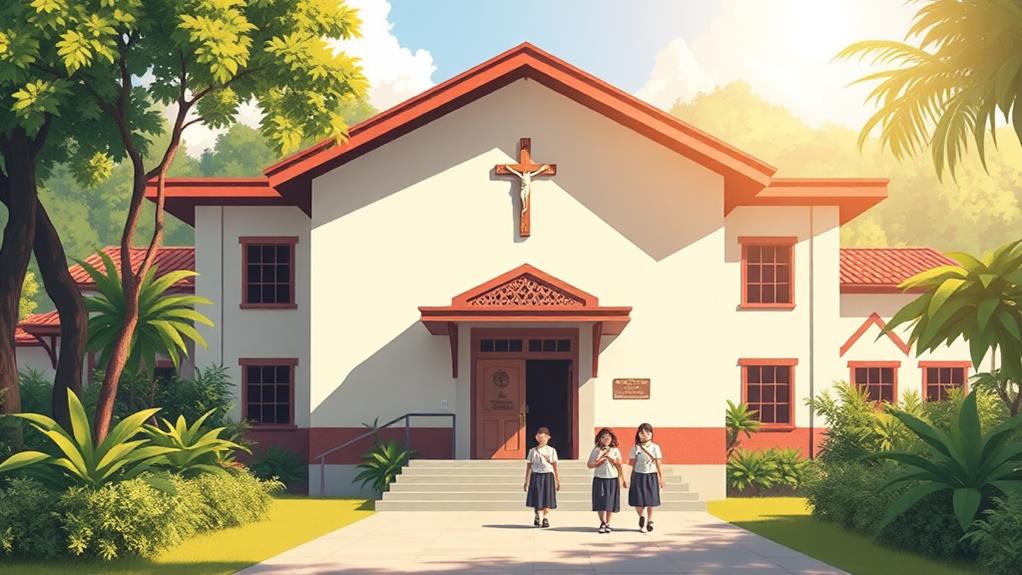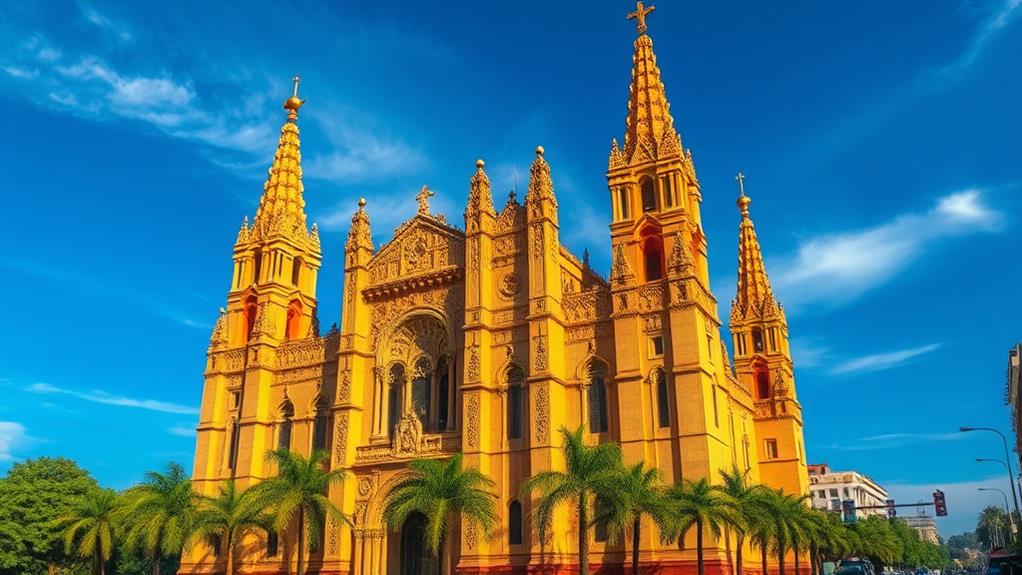Catholicism is a fundamental part of Filipino identity, a legacy of Spanish colonization that began with Ferdinand Magellan's arrival in 1521.
Today, approximately 80% of the Filipino population identifies as Catholic. The Catholic Church plays a significant role in shaping national identity, social justice, and education in the Philippines.
The Church's influence is evident in vibrant celebrations such as the Feast of the Black Nazarene, a popular festival held annually in Manila.
The Church also advocates for human rights, demonstrating its commitment to social justice.
Catholicism's impact is deeply ingrained in Filipino culture and society, with the Church's teachings and values woven into the fabric of daily life.
Historical Roots of Catholicism

The Historical Roots of Catholicism in the Philippines
Catholicism was introduced to the Philippines in 1521 when Ferdinand Magellan arrived on the archipelago. This event marked the beginning of Christianity in the country, with the first recorded mass held in Cebu on March 31, 1521.
By 1546, approximately 250,000 Filipinos had converted to Christianity.
Catholic missions played a crucial role in evangelization and education. Key religious orders such as the Augustinians, Franciscans, Jesuits, and Dominicans facilitated the establishment of these missions.
During the Spanish colonial period (1565-1898), the Catholic Church became the state religion, deeply embedding Catholic practices into Filipino culture and identity.
Today, around 80% of the population identifies as Catholic, reflecting the enduring legacy of Catholicism in the Philippines.
Catholicism has become an integral part of the country's religious traditions, shaping the nation's character and informing its values.
Catholicism and National Identity
Catholicism has significantly shaped the Filipino national identity. By the end of the Spanish colonization period, a staggering 85% of the population identified as Catholic. The rapid conversion of indigenous populations, starting from the first recorded mass in 1521, marked the beginning of significant Catholic influence.
Catholicism has been intertwined with key events in Philippine history. The Philippine Revolution and the People Power Revolution showcased the vital roles of clergy in political activism. During these events, Catholic leaders played crucial parts in shaping the country's identity.
Catholic traditions are deeply integrated into Filipino culture and societal norms. Celebrations like Christmas, Holy Week, and local feasts reflect this integration.
These events demonstrate how Catholicism continues to influence Filipino identity.
Catholicism remains engaged in social justice issues and political matters, underscoring its influence on shaping the modern Filipino national identity. This continued engagement reinforces the significance of Catholicism in the country's identity formation.
The Church's Social and Political Role

The Catholic Church has played a significant role in the Philippines' social and political landscape.
The Church has been a vocal advocate for social justice, particularly during the Philippine Revolution against Spanish rule. Clergy like GOMBURZA inspired nationalist sentiments and pushed for reform.
This legacy continued during the Marcos era, as the Church, led by Cardinal Jaime Sin, became a vocal critic of corruption and human rights abuses, contributing to the People Power Revolution in 1986.
Today, the Church remains actively involved in addressing poverty, human rights, and environmental concerns, influencing public policy and political discourse.
Catholic educational institutions, such as Ateneo de Manila University and De La Salle University, serve as hubs for social activism and community development.
Historically, bishops and clergy have shaped political movements and responses to government actions, often mediating between the state and the populace, thus reinforcing the Church's significant influence in Filipino society.
Traditions and Practices of Filipino Catholics
Filipino Catholicism is a unique blend of indigenous beliefs and Spanish colonial influences. This distinct brand of folk Catholicism is reflected in the country's rich cultural heritage and traditions.
Filipino Catholics celebrate several significant events, including Christmas, Holy Week, and the Feast of the Black Nazarene. These events are marked by vibrant processions and reenactments, showcasing the people's strong Catholic faith.
Devotional practices are an essential part of Filipino Catholicism. This is evident in the regular mass attendance, novenas, and veneration of saints. For instance, during the Feast of the Black Nazarene, devotees practice "Pahalik," or the kissing of the Black Nazarene, as a sign of devotion.
Folk Catholicism is a characteristic feature of Filipino Catholicism, where indigenous beliefs are blended with Catholic practices. This blending of beliefs is reflected in the rituals that pay homage to both saints and ancestral spirits.
The Catholic Church plays a significant role in moral education. In the Philippines, the Church operates numerous schools and universities, emphasizing the importance of moral values in education.
The Catholic Church's Influence on Education

The Catholic Church's influence on education in the Philippines has been profound, shaping the country's educational landscape and instilling values that resonate with the Filipino identity.
Moral education is a key aspect of Catholic schools, where students receive a holistic education that combines academic excellence with moral and values education. This approach fosters spiritual formation and prepares students for life beyond the classroom. For example, Catholic schools often include subjects like Theology and Values Education in their curriculum, which helps students develop a strong moral compass.
Catholic educational institutions have made education accessible and socially responsible by providing affordable education to millions of students, often from underprivileged communities. This not only bridges the education gap but also instills values of community service and social responsibility. Many Catholic schools offer scholarships and financial aid to deserving students, making quality education more accessible to all.
The Catholic Church has also promoted the integration of faith and academics, reflecting its commitment to Catholic education that prepares students for life. Many Catholic schools integrate religious teachings with academic curricula, enabling students to make connections between their faith and everyday life. For instance, Catholic schools may incorporate Bible studies into their history or literature classes, helping students understand the historical and cultural context of religious texts.
Catholic educational programs often prioritize social activism, engaging students in initiatives that address pressing issues like poverty, environmental degradation, and human rights. This reflects the Church's commitment to social justice and encourages students to become active participants in creating positive change. For example, Catholic schools may organize community service projects, such as clean-up drives or charity events, to instill a sense of social responsibility among students.
Catholicism and Social Justice in the Philippines
The Catholic Church's Commitment to Social Justice
The Catholic Church in the Philippines has been a steadfast advocate for social justice, consistently promoting the rights of the marginalized and vulnerable.
The Church has addressed pressing issues such as poverty, human rights, and environmental concerns.
Vocal Advocacy for Human Rights
The Church's commitment to social responsibility is reflected in its initiatives, such as the "Bishops' Pastoral Letter," which has called for the protection of human rights and justice, especially during periods of political unrest and government oppression.
Community Mobilization and Social Action
Through community mobilization, the Church has played a significant role in promoting social action, as seen in the People Power Revolution of the 1980s.
This revolution, led by Corazon Aquino, successfully overthrew the Marcos regime and restored democracy to the country.
Catholic Educational Institutions as Centers for Social Justice
Catholic educational institutions serve as centers for social justice advocacy, providing education and resources to underprivileged communities while promoting awareness of socio-political issues, such as reproductive health and family planning.
These institutions empower individuals to become active participants in addressing social injustices and promoting positive change.
How Did Spanish Colonization Impact Pre-Colonial Catholicism in the Philippines?
Spanish colonization significantly impacted precolonial philippines societies, particularly in terms of religion. The introduction of Catholicism by the Spanish missionaries caused a major shift in the spiritual beliefs and practices of the indigenous people. It led to the syncretism of traditional animistic beliefs with Catholicism, shaping the religious landscape of the Philippines.
The Enduring Legacy of Catholicism

Catholicism's Lasting Impact on Filipino Society
Catholicism has left an indelible mark on the Philippines, shaping the country's cultural, social, and political landscape.
The religion's influence permeates every aspect of life, from grand festivals to quiet moments of devotion.
Cultural Traditions
Catholicism has blended with local customs, resulting in unique practices.
The Feast of the Black Nazarene showcases the country's vibrant cultural heritage, with millions of devotees gathering to celebrate.
Social Justice
The Catholic Church plays a vital role in addressing pressing issues.
It advocates for poverty reduction, human rights, and environmental protection, influencing political discourse and shaping the nation's conscience.
Education
Catholic missions and schools established during Spanish colonization have had a lasting impact on literacy and education.
They fostered a culture of intellectual curiosity and critical thinking, contributing to the country's high literacy rate.
Ongoing Debates and Reflections
The legacy of Catholicism continues to be felt in contemporary Filipino society.
Discussions surrounding traditional teachings and modern values reflect the church's ongoing influence on the nation's identity, as Filipinos navigate the intersection of faith and modernity.
As you explore the Philippines' complex history, you'll discover that Catholicism's influence extends far beyond mere statistics, shaping the very fabric of Filipino identity and culture.
Frequently Asked Questions
What Are the Legacies of Spanish Colonization in the Philippines?
Cultural Assimilation: The Philippines experienced a blending of indigenous practices with Catholic rituals during Spanish colonization. For example, the traditional Filipino festival of Fiesta de San Juan combines native dances with Catholic processions. This cultural fusion is still evident in the country's many festivals and traditions.
Land Ownership and Education Systems: Spanish rule shaped the country's land ownership and education systems. The Encomienda System, introduced by the Spanish, granted lands to conquistadors and forced indigenous people to work on them. This legacy continues to influence the country's linguistic and economic structures.
Additionally, the Spanish introduced a Western-style education system, which emphasized Catholicism and the Spanish language.
Architectural Heritage: The Philippines' architectural heritage still reflects its colonial past. Intramuros, a historic walled city in Manila, is a prime example of Spanish-era architecture. The country's many churches, forts, and government buildings also showcase Spanish influence.
Social Hierarchies: Social hierarchies established during Spanish colonization persist to this day. The Principalia, a class of Filipino nobles, was created by the Spanish to govern local communities. This system perpetuated social stratification, with the elite holding power over the masses.
How Did Spanish Colonization Affect the Philippines' Religion?
Spanish Colonization Brought Significant Changes to the Philippines' Religion
When the Spanish colonized the Philippines, they introduced Catholicism, which drastically altered the country's religious landscape. The Spanish missionaries employed a conversion strategy that blended with indigenous beliefs, resulting in religious syncretism. This cultural assimilation led to the adoption of Catholic ritual practices, which were often influenced by the clergy.
The Fusion of Traditional and Catholic Beliefs
As a result of this syncretism, a unique fusion of traditional and Catholic beliefs emerged. For example, the Filipino celebration of the Fiesta de Santo Niño, which honors the Christ Child, incorporates indigenous music and dance.
Similarly, the Simbang Gabi, a series of nine dawn Masses before Christmas, combines Catholic rituals with traditional Filipino practices.
The Church's Role in Shaping Filipino Identity and Culture
The Catholic Church played a significant role in shaping modern implications on Filipino identity and culture. The Church's influence can be seen in the country's strong family values, respect for authority, and fiestas, which are an integral part of Filipino culture.
Today, the Philippines remains one of the most Catholic countries in Asia, with over 80% of the population identifying as Catholic.
What Religion Is the Greatest Legacy of Spain to the Philippines?
The Catholic faith is the greatest legacy of Spain to the Philippines. Spanish missionaries introduced Catholicism to the islands, where it took root and thrived.
Today, this legacy is evident in the country's vibrant religious festivals, such as the Sinulog Festival in Cebu and the MassKara Festival in Bacolod, which showcase a unique blend of Catholic and Indigenous traditions.
The Catholic faith has also left its mark on the Philippines' architecture, with stunning Churches like the San Agustin Church in Manila and the Miag-ao Church in Iloilo, which are now UNESCO World Heritage Sites.
Furthermore, the Catholic Church has played a significant role in shaping the country's social hierarchy and education system, with many schools and universities established by Catholic religious orders.
How Did the Catholic Church Impact Spanish Colonial Life?
The Catholic Church's Physical Presence
The Catholic Church established a strong physical presence in Spanish colonial life through its architecture. Church buildings were often constructed in the center of towns, symbolizing the Church's authority and dominance. This physical presence reinforced social hierarchies, with the Church at the top and the indigenous population at the bottom.
Shaping Local Values
The Church's education system played a significant role in shaping local values. Moral instruction was emphasized, teaching colonists to prioritize Catholicism and obedience to the Church. This education system helped to create a sense of community and social norms, with the Church at its core.
Cultural Festivals and Identity
Cultural festivals, like Christmas, blended indigenous beliefs with Catholic rituals, creating a unique identity in Spanish colonial life. For example, the Virgin of Guadalupe, a Catholic icon, was often depicted with indigenous features, symbolizing the blending of cultures. These festivals helped to create a sense of community and shared identity among colonists.
Missionary Activities and Economic Structures
Missionary activities had a significant impact on economic structures in Spanish colonial life. Missionaries often established self-sufficient communities, which contributed to the local economy. These communities also helped to spread Catholicism and further solidify the Church's influence.
Political Influence and Governance
The Church exercised significant political influence through parish governance, making it a central authority in daily life. Parish priests often served as local leaders, making decisions on behalf of the community. This governance structure helped to reinforce the Church's authority and control over the colonists.